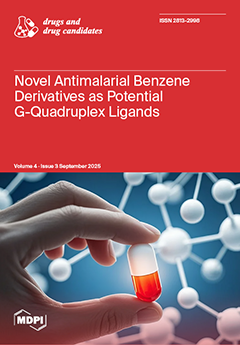Background: Based on our previously reported series of novel 1,3,5-
tris[(4-(substituted-aminomethyl)phenyl)methyl]benzene and 1,3,5-
tris[(4-(substituted-aminomethyl)phenoxy)methyl]benzene derivatives, we have now designed, synthesized, and tested a new series of novel restricted and simplified structural analogues of these compounds against
Plasmodium falciparum in vitro
;
[...] Read more.
Background: Based on our previously reported series of novel 1,3,5-
tris[(4-(substituted-aminomethyl)phenyl)methyl]benzene and 1,3,5-
tris[(4-(substituted-aminomethyl)phenoxy)methyl]benzene derivatives, we have now designed, synthesized, and tested a new series of novel restricted and simplified structural analogues of these compounds against
Plasmodium falciparum in vitro
; i.e., the 1,3-
bis[(4-(substituted-aminomethyl)phenyl)methyl]benzene and 1,3-
bis[(4-(substituted-aminomethyl)phenoxy)methyl]benzene compounds.
Methods & Results: The pharmacological results revealed significant antimalarial activity, with IC
50 values in the submicromolar to micromolar range. Additionally, the in vitro cytotoxicity of these new nitrogen-containing polyphenyl- or -phenoxymethylbenzene compounds was evaluated on human HepG2 cells. The compound
1f, the 1,3-bis[(4-(3-(morpholin-1-yl)propyl)aminomethyl)phenoxy)methyl]benzene derivative, emerged as one of the most potent and promising antimalarial candidates, demonstrating a cytotoxicity/antiprotozoal activity ratio of 594 against the chloroquine-sensitive
Plasmodium falciparum 3D7 strain. Additionally, the 1,3-bis[((substituted aminomethyl)phenyl)methyl]benzene compound
1j and the 1,3-bis[((substituted aminomethyl)phenoxy)methyl]benzenes
2p and
2q also showed strong antimalarial potential, with selectivity indexes (SI) of over 303, 280, and 217, respectively, against the 3D7 strain, which has mefloquine-reduced sensitivity. Furthermore, the 1,3-b
is[(4-(pyridin-2-ylethylaminomethyl)phenyl)methyl]benzene
2k was identified as the most noteworthy antimalarial compound, exhibiting a selectivity index (SI) that was superior to 178 against the chloroquine-resistant
Plasmodium falciparum W2 strain. It has previously been suggested that the telomeres of
P. falciparum may serve as potential targets for these polyaromatic compounds; thus, we assessed the ability of our novel derivatives to stabilize parasitic telomeric G-quadruplexes using a FRET melting assay.
Conclusions: However, regarding the stabilization of the protozoan G-quadruplex, it was noted that the few substituted derivatives, which showed interesting stabilization profiles, were not necessarily the most effective antimalarial compounds against both
Plasmodium strains. Moreover, these new compounds did not show promising stabilizing effects on the different G4 sequences. Therefore, no correlation arises between their antimalarial activity and the selectivity of their binding to G-quadruplexes.
Full article



